Contents- How To Plan A Jaipur Trip...
If you are planning a trip to Jaipur, our comprehensive guide on how to plan a Jaipur trip will help you explore the city’s richness.
Jaipur, the capital of Rajasthan, is famously known as the “Pink City” because of its distinct pink-coloured buildings, Jaipur is a treasure of royal heritage, busy markets, and unique Rajasthani food culture.
This article will cover everything from the city’s history, the best time to visit, where to stay, internal transport options, shopping destinations, and a detailed two-day itinerary.
In this article, I am going to explore Pink City through my previous experience of visiting this city.
History of Jaipur City
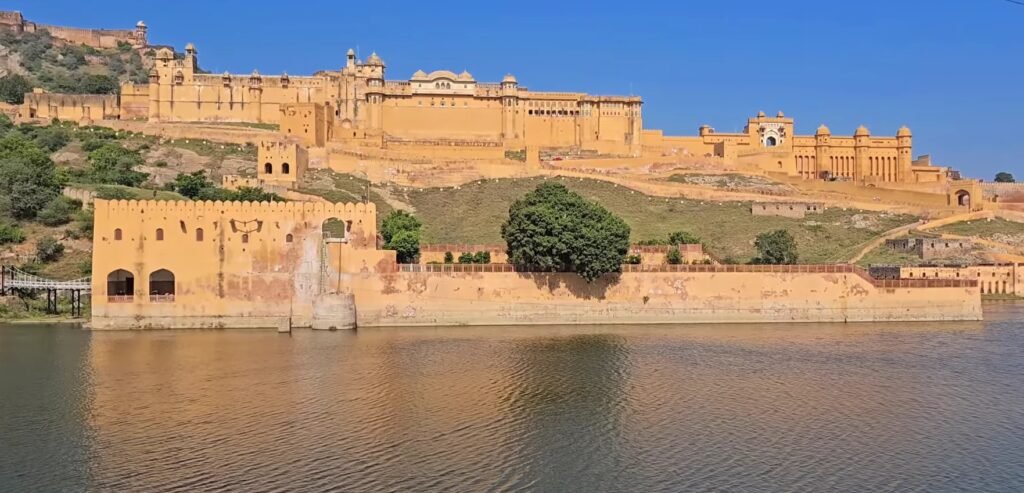
Jaipur was founded in 1727 by Maharaja Sawai Jai Singh II, the ruler of Amber. He shifted the capital from Amber to Jaipur due to the growing population and water scarcity in Amber.
Jai Singh II was a visionary man, skilled in mathematics, architecture, and astronomy. With the help of Vidyadhar Bhattacharya, a talented architect from Bengal, he designed Jaipur using principles of Vastu Shastra (Indian architectural science) and Shilpa Shastra (art and sculpture), making it the first planned city in India. The city is built around nine blocks, showing the nine divisions of the universe, with broad avenues and spacious gardens.
The walled city of Jaipur is now a UNESCO World Heritage Site, recognized for its best urban planning and architectural excellence.
Why Jaipur is called the Pink City?
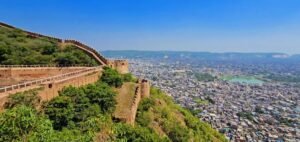
Jaipur got the nickname “Pink City” in 1876 when Maharaja Sawai Ram Singh ordered the entire city to be painted pink to welcome the Prince of Wales (later King Edward VII).
I heard this above story on my last visit and I was amazed after hearing that!!! Pink, traditionally associated with hospitality, was chosen as a symbol of friendliness.
Over time, pink colour became Jaipur’s identity, and the tradition of maintaining the pink colour continues today. The city’s iconic pink-coloured buildings, especially in the old town.
Best Time to Visit Jaipur
Jaipur experiences a desert-like climate, with hot summers, mild winters, and a monsoon season. Therefore I suggest that time of the winter months visit Jaipur for the convenience of you and your family. from October to March, when the weather is pleasant and ideal for sightseeing.
Summer (April to June):
Summers can be extremely hot, with temperatures soaring up to 45°C (113°F). It’s not the ideal season for sightseeing, but if you do visit during this time, early mornings and evenings are more comfortable for exploration.
Warning!!: Please avoid visiting in summer if you are planning to visit Jaipur with family because my experience during a summer visit is not very good.
Monsoon (July to September):
Jaipur receives moderate rainfall, but the humidity is quite high. While the rain can bring some respite from the heat, so you cannot able to perform outdoor activities.
Winter (October to March):
This is the best time to visit Jaipur. The weather is cool, with daytime temperatures ranging between 15°C and 22°C (59°F and 72°F), perfect for exploring the city and its nearby attractions.
Where Can You Stay in Jaipur?
Here you can find a variety of stays to suit every budget, from luxury heritage hotels to affordable guesthouses.
Here I recommend some options to stay in Jaipur, you can choose according to your convenience or budget.
Luxury Stays
Rambagh Palace: A former royal residence, Rambagh Palace offers an unmatched luxury experience with regal rooms, lush gardens, and royal services.
Samode Haveli: This traditional haveli (mansion) offers an experience of Jaipur’s royal past with beautifully decorated rooms and a quiet ambience.
Taj Jai Mahal Palace: Here you can experience a Mughal garden-like atmosphere This 5-star property is well known for its architecture and luxurious amenities.
Mid-Range Options
Alsisar Haveli: A mid-range heritage hotel with traditional Rajasthani decoration, Alsisar Haveli offers an authentic stay without breaking your Pocket.
Hotel Arya Niwas: Known for its hospitality and comfort, Arya Niwas offers clean and affordable rooms with modern amenities.
Shahpura House: This boutique hotel is a former royal residence, providing a blend of traditional charm and modern comforts.
Budget Stays
Zostel Jaipur: A vibrant backpacker hostel with shared dormitories and private rooms, ideal for solo travellers.
Moustache Hostel: Another popular hostel with a youthful vibe, Moustache offers clean dorms, a rooftop area, and a common lounge.
Rawla Rawatsar: A budget-friendly guesthouse offering traditional decor and a home-like atmosphere.
Places to visit in Jaipur
Amber Fort Jaipur
Location: Google Maps
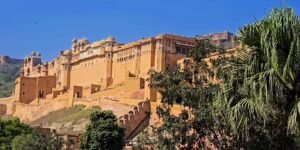
Amber Fort (also known as Amer Fort) is Rajasthan’s most famous and most visited attraction. Located about 11 kilometres from the city, Amber Fort is a mixture of Hindu and Mughal architectural styles. Built-in 1592 by Raja Man Singh I, it is located on a hilltop overlooking Maota Lake. The fort is evidence of Rajasthan’s royal history and offers heart-touching views of the surrounding landscape.
Key Attractions:
Sheesh Mahal (Hall of Mirrors)
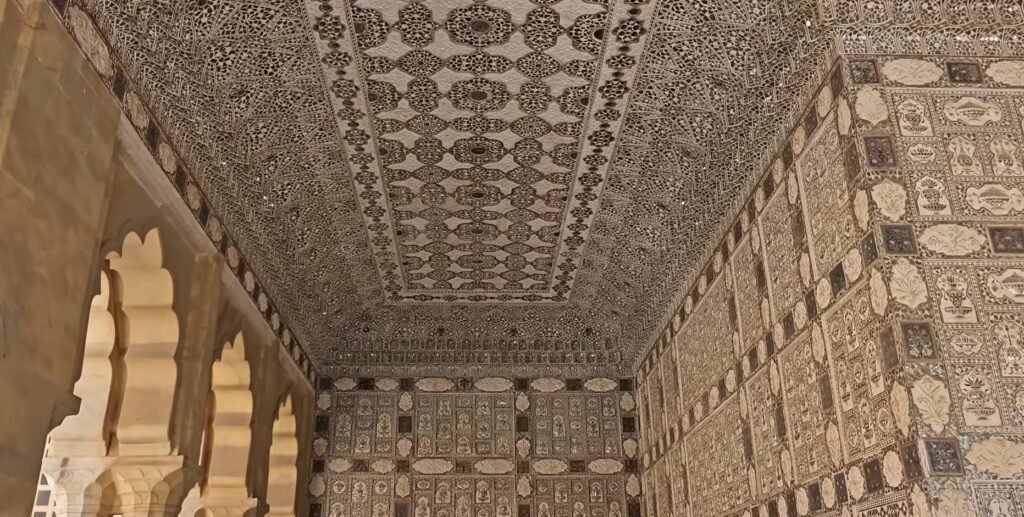
Diwan-e-Aam (Hall of Public Audience)
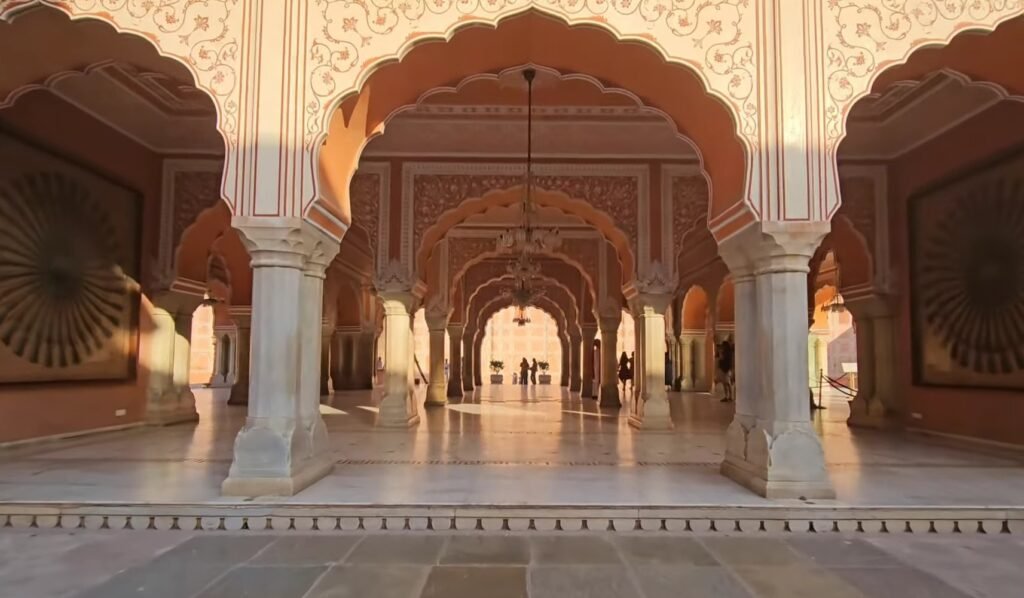
Sukh Niwas (The Hall of Pleasure)
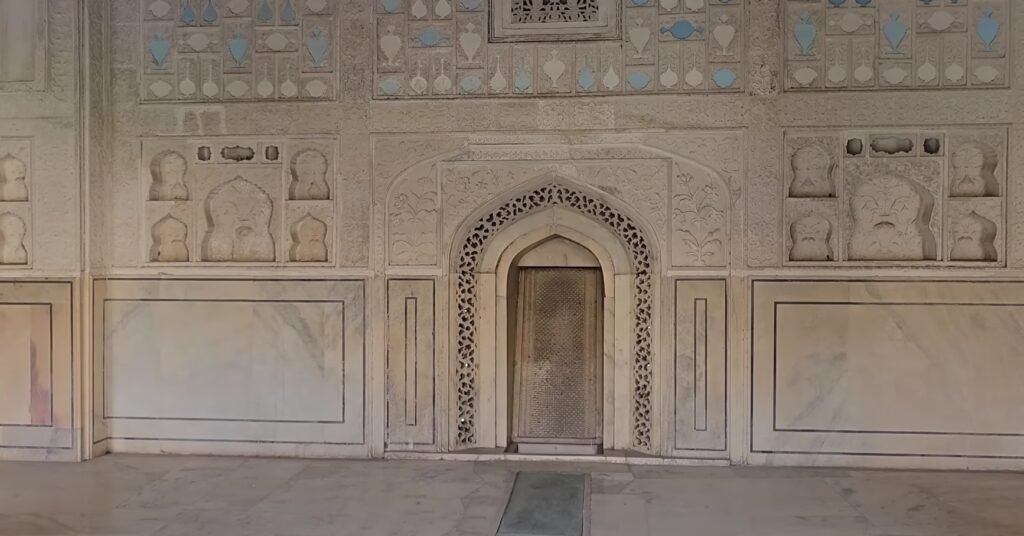
You can also opt for an Elephant ride up to the fort’s Entrance. It will cost you around INR 2000, So I suggest you take a Jeep Ride instead of this costly elephant ride.
Entry Fee: INR 100 for Indians, INR 500 for foreigners
Timings: 8:00 AM to 5:30 PM
Amber Fort’s majestic beauty and history make it a must-visit for you.
The City Palace Jaipur
Location: Google Maps

Located in the heart of the city, the City Palace is a mixture of Rajput, Mughal, and European architectural styles. Built by Maharaja Sawai Jai Singh II in 1727. the palace is still home to the royal family of Jaipur.
It’s the main palace complex that houses various palaces, courtyards, galleries, and museums. The palace gives visitors a close look into the royal lifestyle of Jaipur’s rulers.
Key Attractions:
Chandra Mahal (The main palace)
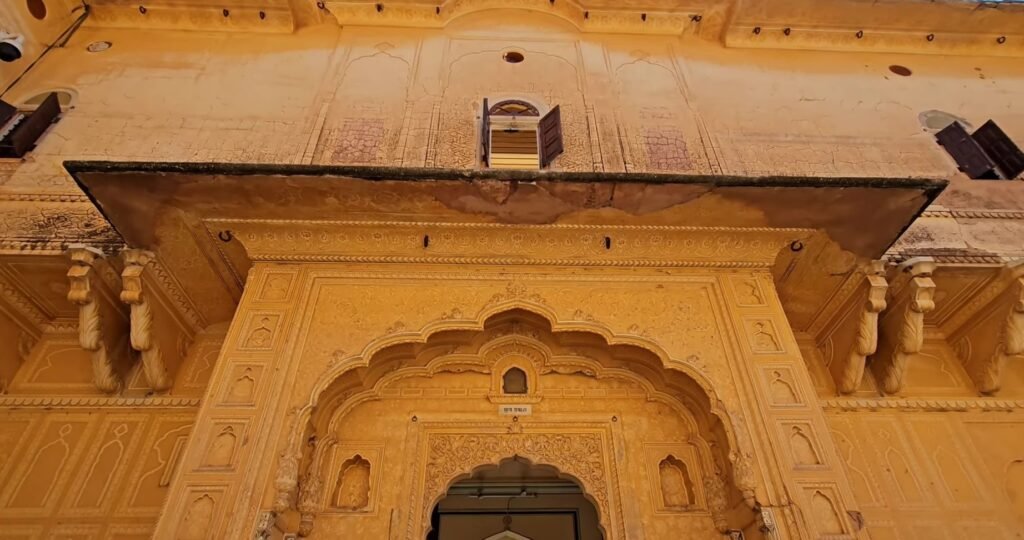
Mubarak Mahal (Welcome Palace)

Pritam Niwas Chowk (Peacock Gate)
Museum of royal costumes, weapons, and art
Entry Fee: INR 200 for Indians, INR 700 for foreigners.
Timings: 9:30 AM to 5:00 PM
I enjoyed this living example of Jaipur’s royal heritage and one of the most significant places to visit in Jaipur.
Hawa Mahal
Jaipur
Location: Google Maps

The Hawa Mahal, built in 1799 by Maharaja Sawai Pratap Singh, is one of the most famous landmarks of Jaipur. This five-story pink sandstone structure has 953 small windows, or jharokhas, designed to allow royal women to observe street festivals and everyday life without being seen by others.
The structure’s unique honeycomb design makes it an architectural marvel.
Key Attractions:
Funny Thing To Do: You can count these 953 windows!!!, you won’t feel bored while doing this.
Views of the Jantar Mantar and City Palace from the top.
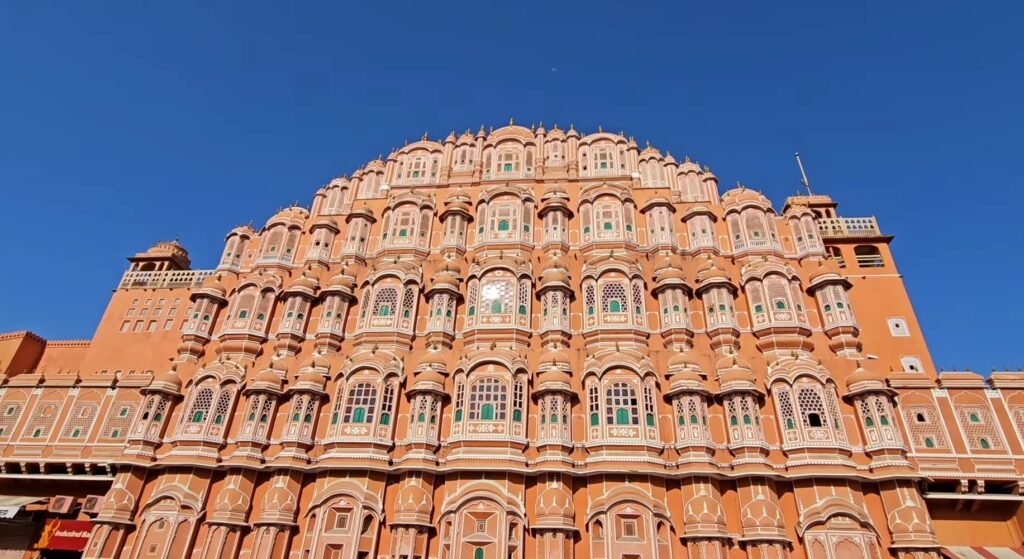
Intricate latticework and Rajputana architecture
Entry Fee: INR 50 for Indians, INR 200 for foreigners
Timings: 9:00 AM to 4:30 PM
Hawa Mahal is a symbol of Jaipur and a significant part of its cultural identity.
Extra Tip For You: please do not forget to capture the stunning view at sunrise when the building glows in golden colour.
Jantar Mantar
Jaipur
Location: Google Maps
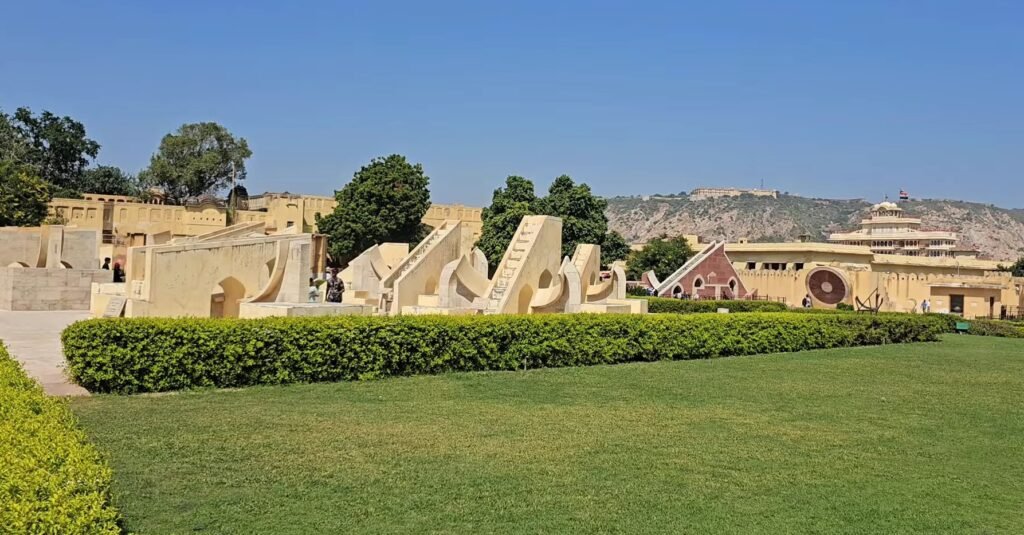
A UNESCO World Heritage Site, Jantar Mantar is an astronomical observatory built by Maharaja Sawai Jai Singh II in 1734. It contains the world’s largest stone sundial and 19 other instruments designed to observe astronomical positions with the naked eye. Jantar Mantar is one of the best-preserved observatories in India and is still used for astronomical purposes today.
Key Attractions:
Samrat Yantra (The giant sundial)
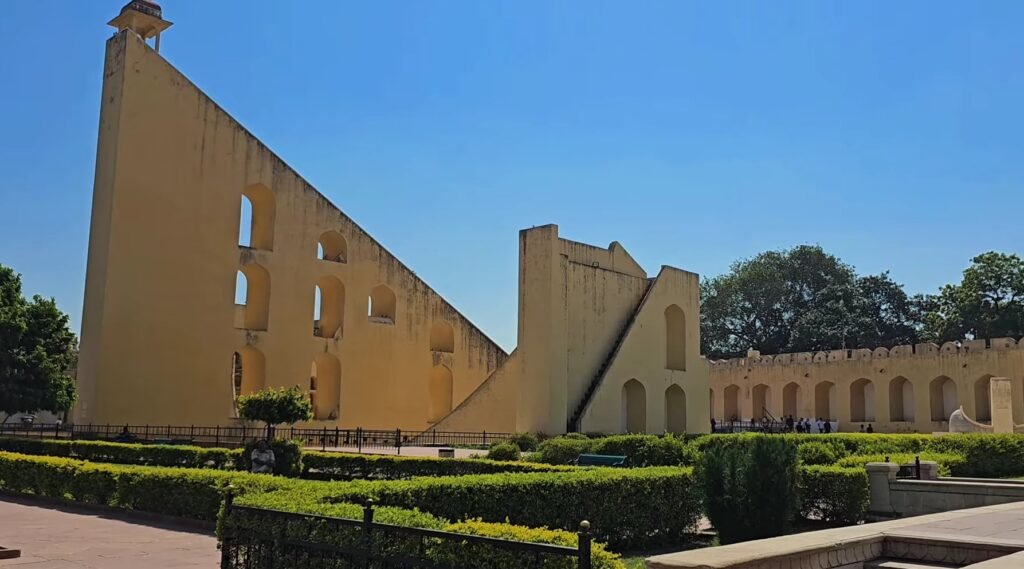
Jaiprakash Yantra (Used for locating stars)
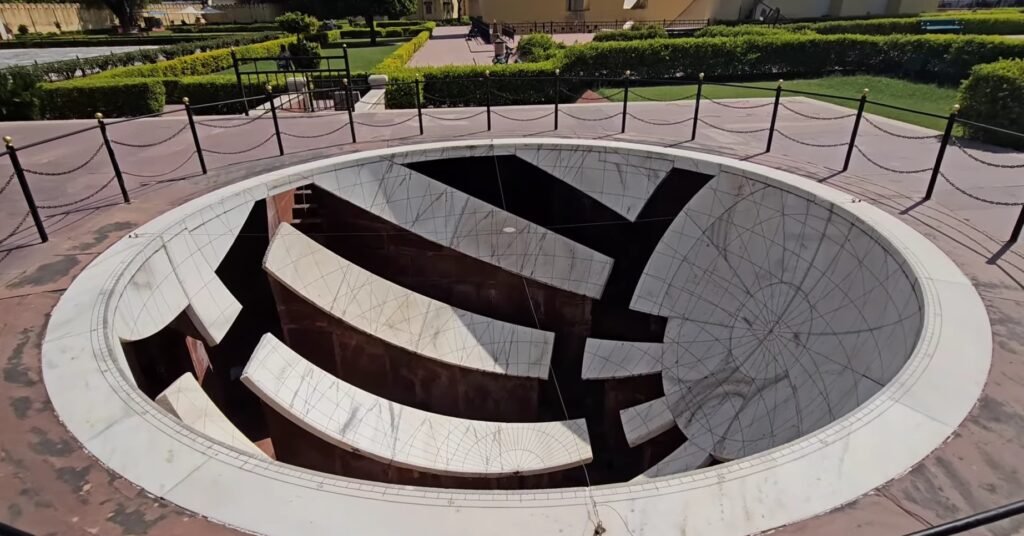
Rashivalaya Yantra (Zodiac circle instrument)
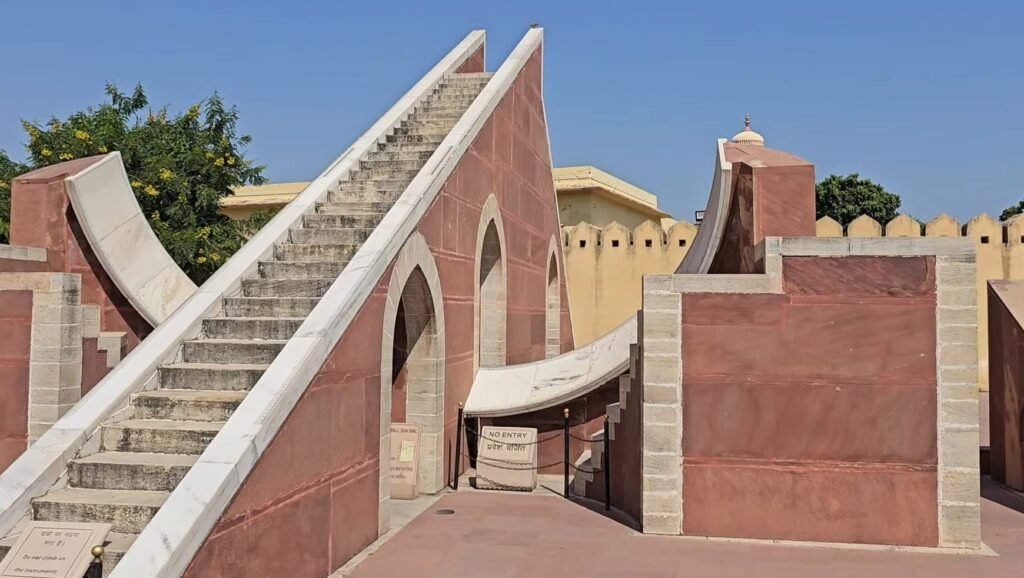
Entry Fee: INR 50 for Indians, INR 200 for foreigners.
Timings: 9:00 AM to 4:30 PM
Jantar Mantar is a unique attraction that blends science, architecture, and art.
Tip: It’s a must-visit place if you are interested in astronomy and history.
My Reaction after visiting Jantar Mantar: What great work by Maharaja Sawai Jai Singh II hat’s off to you!!!
Jal Mahal
(Water Palace)
Jaipur
Location: Google Maps

The Jal Mahal, located in the middle of Man Sagar Lake, is one of Jaipur’s most scenic and photographed places. Built in the 18th century by Maharaja Madho Singh I, this palace appears to float on the lake, offering an ethereal view, especially at dawn or dusk.
Although the palace is not open to the public, the surrounding area is popular for photography and bird watching.
Key Attractions: Stunning views of the palace and lake
Photography at sunrise or sunset
Birdwatching in the surrounding area
Entry Fee: No entry fee; viewing from the lakeside is free
Timings: Best visited during sunrise and sunset
Jal Mahal is the perfect spot for a relaxing break, offering a peaceful atmosphere and beautiful views.
Nahargarh Fort Jaipur
Location: Google Maps
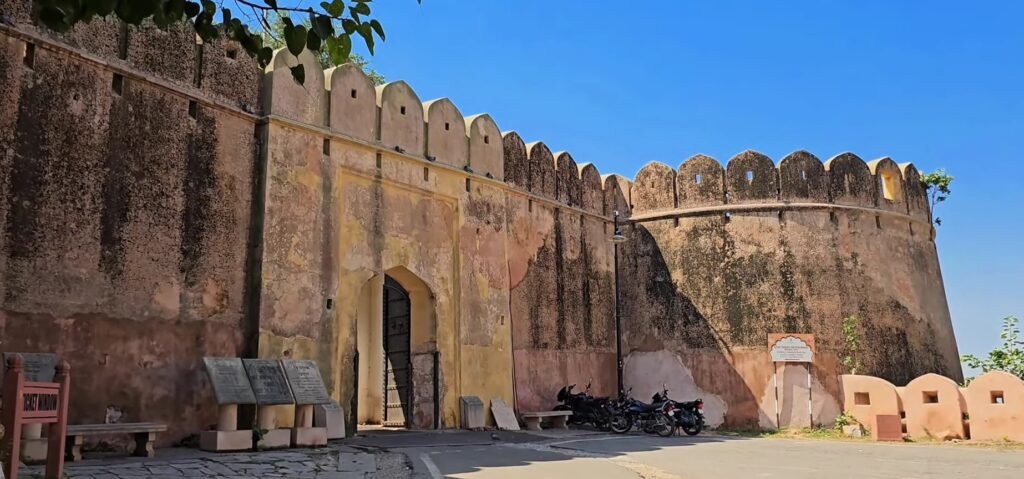
Situated high on the Aravalli Hills, Nahargarh Fort offers panoramic views of Jaipur. Built-in 1734 by Maharaja Sawai Jai Singh II, the fort once served as a defence mechanism for the city and a retreat for the royal family. The fort is especially popular for sunset views and is a peaceful view of Jaipur city.
A view of Jaipur city from this fort amazed me, you should not miss it at any cost.
Key Attractions:
Breathtaking views of Jaipur from the hilltop
Madhavendra Bhawan, a palace with amazing design
Nahargarh Stepwell is a geometric marvel.
Entry Fee: INR 50 for Indians, INR 200 for foreigners
Timings: 10:00 AM to 6:00 PM
Nahargarh Fort is ideal for those who want to enjoy scenic beauty while visiting Jaipur.
Jaigarh Fort Jaipur
Location: Google Maps
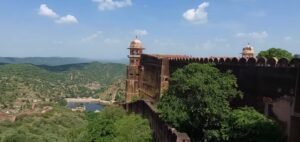
Known as the Fort of Victory, Jaigarh Fort was built in 1726 by Jai Singh II and is located on the Cheel ka Teela (Hill of Eagles). The fort was used to protect Amber Fort and contains the world’s largest cannon on wheels, Jaivana.
With its thick walls and strong exterior, Jaigarh Fort stands as a symbol of Rajasthan’s military power.
Interesting fact:
This Jaivana cannon has only been used one time, it has a range of 35 km with a total weight of 150 tons, I feel excited with a little bit of fear while watching this hugeeee… cannon!!!
Key Attractions:
Jaivana Cannon
Panoramic views of the Amber Fort and the surrounding landscape
The fort’s armoury museum.
Entry Fee: INR 50 for Indians, INR 200 for foreigners
Timings: 9:00 AM to 4:30 PM
Jaigarh Fort is a must-visit for history lovers and those interested in Rajasthan’s military architecture.
Albert Hall Museum Jaipur
Location: Google Maps

The Albert Hall Museum, located in Ram Niwas Garden, is the oldest museum in Rajasthan. Built in 1876, the museum represents a rich collection of artefacts, including paintings, ivory work, textiles, metal sculptures, and an Egyptian mummy.
This museum is built with Indo-Saracenic architecture which is very impressive.
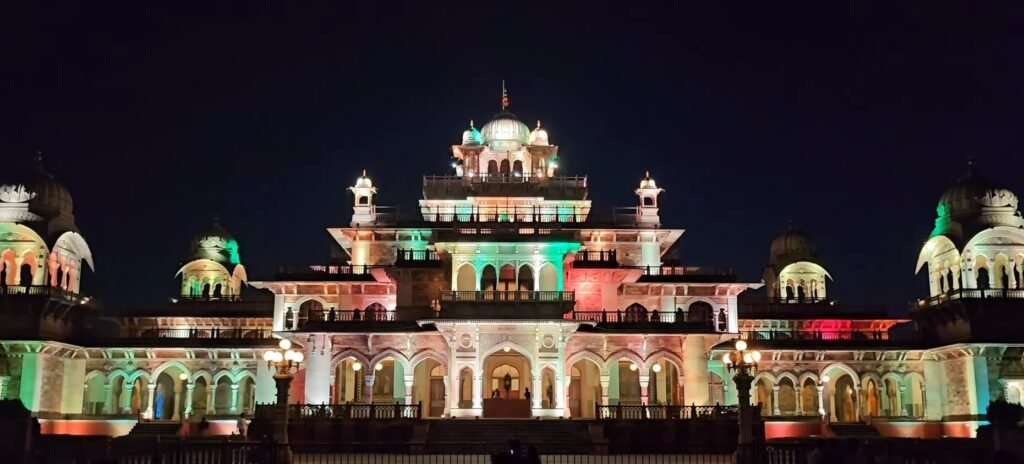
Its nighttime view with lighting will surely surprise you. Do not miss to enjoy its night view.
Attractions:
Collection of ancient artefacts and royal military weapons.
An Egyptian mummy will excite you
Decorative arts from Rajasthan
Entry Fee: INR 40 for Indians, INR 300 for foreigners
Timings: 9:00 AM to 5:00 PM
Albert Hall Museum offers you a tour of Rajasthan’s cultural and artistic history, making it a must-visit for museum lovers.
Galtaji Temple (Monkey Temple) Jaipur
Location: Google Maps
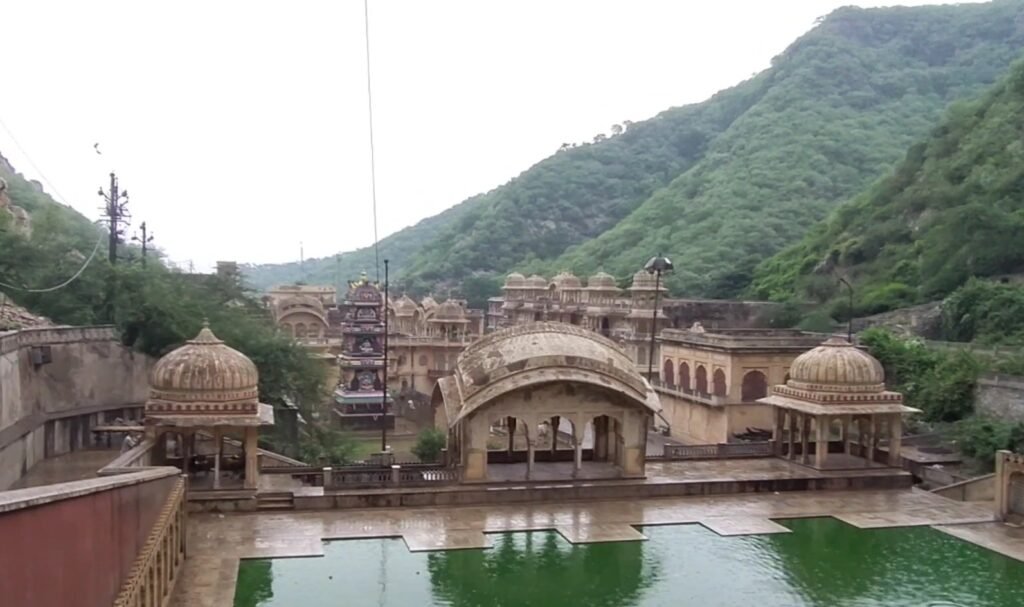
Situated outside of Jaipur, the Galtaji Temple is a unique pilgrimage site built within a narrow gorge. The temple complex is known for its natural springs that fill a series of sacred water tanks where pilgrims come to bathe.
It’s also famous for the large population of monkeys that reside here, earning it the nickname Monkey Temple.
Bath is considered very pure and sacred. During my visit to this temple, I saw no one going from here without a bath.
Key Attractions: Sacred water tanks for bathing
The beautiful temple architecture
Friendly monkeys
Entry Fee: Free entry
Timings: 5:00 AM to 9:00 PM
For me, Galtaji Temple is a spiritual experience that offers peace of mind and feel of pureness.
Jaipur Markets
Shopping in Jaipur
No trip to Jaipur is complete without doing some shopping. The city is a shopper’s paradise, offering everything from traditional jewellery to handicrafts and textiles. Here’s what you need to know when you plan a Jaipur trip and want to explore its markets:
Johari Bazaar:
Location: Google Maps
Famous for its gemstone jewellery, particularly Kundan, Meenakari, and Polki, Johari Bazaar is a must-visit for jewellery lovers. You’ll also find beautiful traditional textiles and sarees here.
Bapu Bazaar:
Location: Google Maps
For those interested in textiles and traditional Rajasthani prints, Bapu Bazaar is the place to be. From bandhani dupattas to Jaipuri quilts, this market has it all. Don’t forget to bargain to get the best deals.
Tripolia Bazaar:
Location: Google Maps
Known for its lac bangles and brassware, Tripolia Bazaar offers a wide range of Rajasthani handicrafts. You can also find carpets and textiles here.
Chandpole Bazaar:
Location: Google Maps
This market is famous for marble sculptures, including idols of gods and goddesses. If you’re interested in traditional crafts, you’ll find plenty of options here.
Nehru Bazaar:
Location: Google Maps
For Rajasthani jootis (traditional footwear) and handicrafts, Nehru Bazaar is the place to go. It’s a great spot for picking up some special items and gifts. When you plan your Jaipur trip, make sure to spend at least one day for shopping. The city’s markets are huge and full of unique finds that you won’t want to miss.
TIP: During my last visit we spent a day in shopping, so you need to plan accordingly. but my suggestion is please do not skip shopping in Jaipur, otherwise, you are going to miss a very unique experience…
Shopping in Jaipur is a special experience in itself. Don’t forget to bargain and explore the vibrant street life while picking up unique items for you and your family…
Local Food and Dining in Jaipur.
Jaipur is not only known for its architecture and rich culture but also for its mouth-watering local cuisine. The city’s food scene offers a diverse range of traditional Rajasthani dishes that are sure to excite your taste.
Must-Try Dishes in Jaipur:
Dal Baati Churma:
This iconic Rajasthani dish consists of baked wheat balls (baati) served with dal (lentils) and a sweet churma. Chokhi Dhani and LMB (Laxmi Misthan Bhandar) are popular places to try this dish.
Laal Maas:
A fiery mutton curry made with red chillies, Laal Maas is a Rajasthani delicacy that you must try. Handi Restaurant on MI Road is famous for its Laal Maas.
Pyaaz Kachori:
A spicy fried snack filled with onion and spices, Pyaaz Kachori is a popular street food in Jaipur. Rawat Mishthan Bhandar is one of the best places to try this snack.
Ghewar:
This traditional Rajasthani sweet is made during festivals like Teej and Raksha Bandhan. LMB is famous for its Ghewar, and it’s a perfect souvenir to take back home.
Lassi:
Cool down with a glass of thick, creamy lassi, served in a traditional clay pot. Lassiwala on MI Road is the go-to spot for this refreshing drink.
Don’t forget to explore the street food when you plan your Jaipur trip. From golgappas to kachoris, Jaipur’s streets offer a variety of flavours that will leave you wanting more.
Ghewar:
A traditional sweet made from flour and soaked in sugar syrup often enjoyed during festivals like Teej.
Pyaaz Kachori:
A deep-fried pastry stuffed with a spicy onion filling, perfect for snacking.
Ker Sangri:
A typical Rajasthani dish made from dried wild berries and beans, cooked with yoghurt and spices.
Best Places to Try Local Food:
Laxmi Misthan Bhandar (LMB):
Location: Google Maps
Famous for its Rajasthani thali and sweets, especially ghewar.
Chokhi Dhani:
Location: Google Maps
A themed village resort offering a traditional Rajasthani dining experience, complete with folk performances.
Rawat Mishthan Bhandar:
Location: Google Maps
Known for its pyaaz kachori and other snacks.
Spice Court:
Location: Google Maps
A well-known restaurant to try Laal Maas and other traditional Rajasthani delicacies.
Govindam Retreat:
Location: Google Maps
A spot to enjoy authentic vegetarian Rajasthani food in a beautiful heritage setting.
Exploring the local food in Jaipur is an essential part of experiencing the city’s rich culture and traditions.
I think your family will feel very happy after testing these traditional Rajasthani items so, if you are planning to visit with a family then this visit is a must for you.
Two-Day Itinerary for Jaipur
When you plan a Jaipur trip, two days are sufficient to cover the major attractions. Here’s a detailed two-day itinerary to help you make the most of your time:
Day 1: Explore the Old City and Iconic Landmarks
Day 1: Itinerary Map
Spend a couple of hours exploring the beautifully preserved courtyards, buildings, and gardens. The time required to explore the city palace is around 1 to 2 hours.
Mid-Morning: about a short walk from the City Palace is the Jantar Mantar, an astronomical observatory built by Maharaja Jai Singh II. It’s a UNESCO World Heritage site and features the world’s largest stone sundial.
You can explore the giant astronomical instruments that were used to measure time and track celestial bodies. It nearly requires 1 to 2 hours to explore the observatory of Jantar Mantar.
Late Morning: Head to the iconic Hawa Mahal (Palace of Winds), one of Jaipur’s most famous landmarks. The palace has 953 small windows (called jharokhas) that were designed for royal women to observe street festivities without being seen by other people.
The honeycomb structure and intricate latticework make for some excellent photo opportunities. 1 hour time is sufficient to completely explore the Hawa Mahal
Lunch: For lunch, head to Laxmi Misthan Bhandar (LMB), located near Johari Bazaar. It’s one of Jaipur’s oldest and most renowned spots, famous for its traditional Rajasthani thali and sweets. Try their famous dal baati churma or the flavorful ghewar.
Afternoon: After lunch, visit the Albert Hall Museum, located in Ram Niwas Garden. This museum is one of the oldest in Rajasthan and houses an impressive collection of artefacts, including paintings, carpets, ivory items, and sculptures.
The building itself is an architectural marvel with Indo-Saracenic design influences.
Evening: you can conclude up your first day by visiting the Birla Mandir, a white marble temple dedicated to Lord Vishnu and Goddess Lakshmi. The temple glows beautifully in the evening, and its peaceful atmosphere offers a great way to relax after a long day of sightseeing.
Please don’t miss to capture the night photos of this temple which is glowing beautifully.
Dinner: For dinner, you must opt for a royal Rajasthani meal at 1135 AD, located inside the Amber Fort. The restaurant offers traditional Rajasthani dishes, with views of the illuminated fort.
During my last visit, I enjoyed dinner at this place so my suggestion is a visit to this place is a must.
Day 2: Amber Fort, Jal Mahal, and Shopping
Day 2: Itinerary Map
Morning: Start your second day by heading towards the majestic Amber Fort, located about 11 kilometres from Jaipur. The fort is one of Rajasthan’s most important historical sites and is known for its beautiful mixture of Hindu and Mughal architecture.
It was also granted the status of UNESCO World Heritage Site in 2013. Take an elephant ride up to the fort’s main entrance or walk up the steep path. Inside the fort, explore the Sheesh Mahal (Mirror Palace), Diwan-i-Aam (Hall of Public Audience), and the beautiful Kesar Kyari Garden.
Special tip: As you know this fort is huge and it requires around 2 to 3 hours to explore it completely so plan your visit as early as possible in the morning.
Mid-Morning: After exploring Amber Fort, stop at Jal Mahal, located on the way back to the city centre. Jal Mahal is a beautiful palace situated in the middle of Man Sagar Lake.
While entry into the palace is not allowed, you can enjoy its beautiful views from the shore and take photos of this architectural marvel reflected in the water.
Lunch: Head back to the city for lunch at Handi Restaurant on MI Road, where you can enjoy their famous Laal Maas and other Rajasthani dishes. The restaurant is well-known for its traditional food and comfortable ambience.
Afternoon: Post-lunch, spend your afternoon shopping in Jaipur’s vibrant markets. Start with Johari Bazaar for jewellery and gemstones. Move on to Bapu Bazaar for textiles, where you can find block-printed fabrics, sarees, and quilts.
If you’re interested in picking up handicrafts, visit Tripolia Bazaar for lac bangles and brassware. Generally, 2 to 3 hours are sufficient for shopping in the different markets of Jaipur.
Evening: End your day with a visit to Nahargarh Fort located on the High hills of Aravali, which offers panoramic views of Jaipur. The fort is especially beautiful at sunset, with a café located within the fort where you can grab a quick snack while enjoying the stunning view.
Special tip: Please don’t miss the panoramic view of the pink City from Nahargarh Fort you can also capture some snapshots of the city from this fort.
Dinner: For your last dinner in Jaipur, enjoy a cultural night at Chokhi Dhani, an ethnic village resort that offers a complete Rajasthani experience. You can enjoy traditional Rajasthani food along with folk dances, puppet shows, camel rides, and more
Tips On How To Plan a Jaipur Trip
Best Time to Book Hotels: When you plan a Jaipur trip, especially during peak tourist season (October to March), make sure to book your accommodation well in advance to avoid high prices and limited availability.
Local Guides: you can hire a local guide to increase the touch of history, especially at historical sites like Amber Fort and City Palace. Many official guides are well-versed in the history and stories behind the attractions, making your trip more informative and engaging.
Stay Hydrated: Jaipur’s dry climate can leave you dehydrated quickly, especially if you’re visiting in the summer. Always carry a water bottle and wear sunscreen.
Cultural Sensitivity: When visiting temples or other religious places, make sure to dress modestly and remove your shoes before entering. And always follow local customs and traditions.
Bargain in Markets: Jaipur’s markets are famous for their handicrafts and textiles, but don’t hesitate to bargain. Most shopkeepers expect it and you can often get a better deal.
Conclusion
Jaipur is a city that will leave you in awe with its architectural marvels, rich history, vibrant culture, and delicious dishes. Whether you are visiting for the first time or returning for another visit, this guide on how to plan a Jaipur trip will ensure that you make the most of your time in this incredible city.
From exploring historical forts and palaces to local flavours and shopping in bazaars, Jaipur has something for everyone.
By following this itinerary and the tips provided, you’ll have a hassle-free and memorable experience.
Whether you’re looking to immerse yourself in Jaipur’s royal past or simply soak in the beauty of the Pink City, planning your trip well in advance will allow you to enjoy everything Jaipur has to offer to the fullest.
Now that you have all the details, it’s time to pack your bags for a journey to one of India’s most beautiful cities! Happy journey and goodbye to all of you…
Also Read: How To Plan Hampi Trip


1 thought on “How To Plan A Jaipur Trip (2024)”